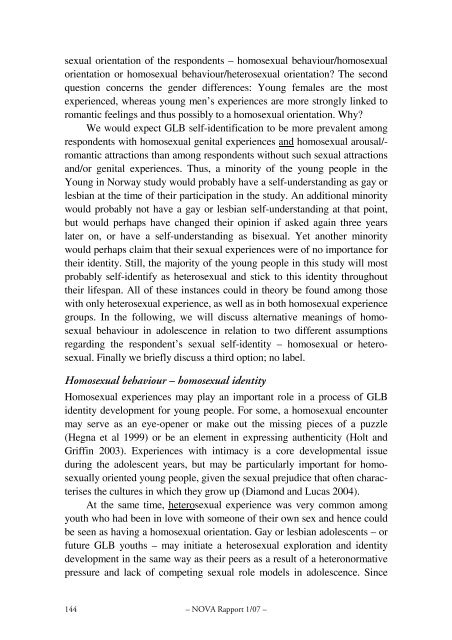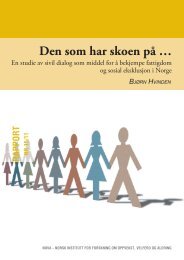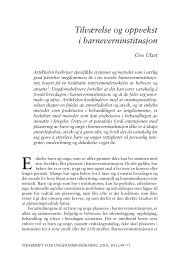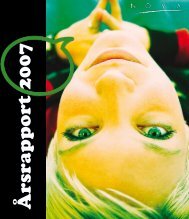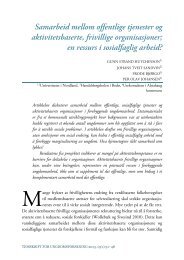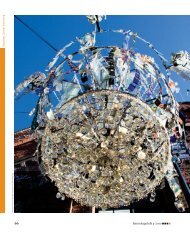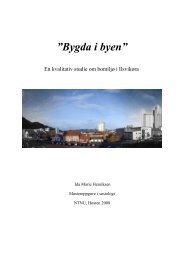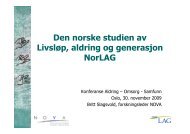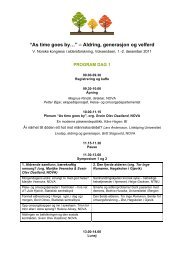Betydningen av seksuell erfaring, tiltrekning og identitet for ...
Betydningen av seksuell erfaring, tiltrekning og identitet for ...
Betydningen av seksuell erfaring, tiltrekning og identitet for ...
You also want an ePaper? Increase the reach of your titles
YUMPU automatically turns print PDFs into web optimized ePapers that Google loves.
sexual orientation of the respondents – homosexual beh<strong>av</strong>iour/homosexual<br />
orientation or homosexual beh<strong>av</strong>iour/heterosexual orientation? The second<br />
question concerns the gender differences: Young females are the most<br />
experienced, whereas young men’s experiences are more strongly linked to<br />
romantic feelings and thus possibly to a homosexual orientation. Why?<br />
We would expect GLB self-identification to be more prevalent among<br />
respondents with homosexual genital experiences and homosexual arousal/romantic<br />
attractions than among respondents without such sexual attractions<br />
and/or genital experiences. Thus, a minority of the young people in the<br />
Young in Norway study would probably h<strong>av</strong>e a self-understanding as gay or<br />
lesbian at the time of their participation in the study. An additional minority<br />
would probably not h<strong>av</strong>e a gay or lesbian self-understanding at that point,<br />
but would perhaps h<strong>av</strong>e changed their opinion if asked again three years<br />
later on, or h<strong>av</strong>e a self-understanding as bisexual. Yet another minority<br />
would perhaps claim that their sexual experiences were of no importance <strong>for</strong><br />
their identity. Still, the majority of the young people in this study will most<br />
probably self-identify as heterosexual and stick to this identity throughout<br />
their lifespan. All of these instances could in theory be found among those<br />
with only heterosexual experience, as well as in both homosexual experience<br />
groups. In the following, we will discuss alternative meanings of homosexual<br />
beh<strong>av</strong>iour in adolescence in relation to two different assumptions<br />
regarding the respondent’s sexual self-identity – homosexual or heterosexual.<br />
Finally we briefly discuss a third option; no label.<br />
Homosexual beh<strong>av</strong>iour – homosexual identity<br />
Homosexual experiences may play an important role in a process of GLB<br />
identity development <strong>for</strong> young people. For some, a homosexual encounter<br />
may serve as an eye-opener or make out the missing pieces of a puzzle<br />
(Hegna et al 1999) or be an element in expressing authenticity (Holt and<br />
Griffin 2003). Experiences with intimacy is a core developmental issue<br />
during the adolescent years, but may be particularly important <strong>for</strong> homosexually<br />
oriented young people, given the sexual prejudice that often characterises<br />
the cultures in which they grow up (Diamond and Lucas 2004).<br />
At the same time, heterosexual experience was very common among<br />
youth who had been in love with someone of their own sex and hence could<br />
be seen as h<strong>av</strong>ing a homosexual orientation. Gay or lesbian adolescents – or<br />
future GLB youths – may initiate a heterosexual exploration and identity<br />
development in the same way as their peers as a result of a heteronormative<br />
pressure and lack of competing sexual role models in adolescence. Since<br />
144<br />
– NOVA Rapport 1/07 –


